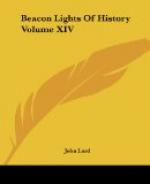AUTHORITIES.
Experimental Researches in Electricity. By Michael Faraday. From the Philosophical Transactions.
Abstracts of the Philosophical Transactions from 1800 to 1837.
Faraday’s Experimental Researches in Electricity and Magnetism. 3 vols.
Life and Letters of Faraday. By Dr. Bence Jones.
Michael Faraday. By J.H. Gladstone.
Students’ Text-Book of Electricity. By
Henry M. Noad. Revised by W.H.
Preece.
Michael Faraday. By John Tyndall.
Pioneers of Electricity. By J. Munro.
Dynamo-Electric Machinery. By Silvanus P. Thompson.
A Dictionary of Electrical Words, Terms, and Phrases.
By Edwin J.
Houston.
Electricity and Magnetism. By Edwin J. Houston.
Electricity One Hundred Years Ago and To-Day. By Edwin J. Houston.
Magnetism; Electro-Technical Series. By Edwin
J. Houston and Arthur E.
Kennelly.
Electro-Dynamic Machinery. By Edwin J. Houston and A. E. Kennelly.
RUDOLF VIRCHOW.
1821-1902.
MEDICINE AND SURGERY.
BY FRANK P. FOSTER, M.D.
Stagnation was the state of medicine when the Nineteenth Century opened. It was only three years before that Jenner had announced and demonstrated the protective efficacy of vaccination against small-pox. His teaching, in spite of the vehement cavillings of the “antis” of his day, gained credence readily, and vaccination speedily became recognized and was constantly resorted to, but hardly any attempt at perfecting the practice was made until after more than fifty years had elapsed. His discovery—or, rather, his proof of the truth of a rustic tradition—fell like a pebble into the doldrums; the ripple soon subsided, and nobody was encouraged to start another. At the present time such an announcement would be promptly followed by investigations leading up to such doctrines as that of the attenuation of viruses and that of antitoxines. But the times were not ripe for anything of that sort; medicine reposed on tradition, or at best gave itself only to such plausibilities in the way of innovation as were cleverly advocated. Physicians strove not to advance the healing art; as individuals, they were content to rely on their manners, their tact, and their assumption of wisdom. In short, the body medical was in a state of suspended animation, possessed of a mere vegetative existence.
The Humoral pathology, or that doctrine of the nature of disease which ascribed all ailments to excess, deficiency, or ill “concoction” of some one of the four humors (yellow and black bile, blood, and phlegm), had not yet lost its hold on men’s convictions, or at least not further than to make them look upon exposure to cold and errors of diet as amply explanatory of all diseases not plainly infectious.




